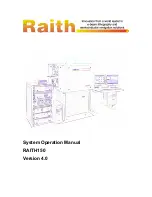
14
|
ni.com
|
NI 449
x
Calibration Procedure
8.
If verifying an NI 4495, repeat steps 2 through 7 for each gain setting that your device
supports. Refer to Table 17 for the gain settings supported by NI 449x devices. In step 2,
change the output of the voltage source based on the gain setting that is being verified.
Table 15 lists the DC voltage to use for each gain setting. When performing step 3, adjust
the gain parameter appropriately.
If verifying an NI 4492/4497/4499, repeat steps 2 through 7 for each gain setting that your
device supports. Refer to Table 17 for the gain settings supported by NI 449x devices. For
each gain setting, including 0 dB, separately verify at sample rates of 102.4 kS/s and
204.8 kS/s. In step 2, change the output of the voltage source based on the gain setting that
is being verified. Table 15 lists the DC voltage to use for each gain setting. When
performing step 3, adjust the gain and sample rate parameters appropriately.
9.
Repeat steps 1 through 8 for all input channels on the device. Connect the output of the
voltage source to the channel being verified during step 1. In step 3, replace
ai0
in the
physical channel parameter with the channel being verified.
Timebase Frequency Accuracy Verification (Optional)
Note
As the timebase frequency accuracy specification is listed as typical, this
procedure is provided without minimum and maximum accuracy limits and is noted
as optional.
This section describes the process used to verify the frequency accuracy of the timebase on all
NI 449x devices. All analog inputs on a single device use the same timebase circuitry. Therefore,
the measurements made on one channel are valid for all channels.
Complete the following steps to verify the timebase:
1.
Connect the function generator to channel AI 0 on the device.
2.
Configure the function generator to generate a 10 kHz sine with an amplitude of 9 V
pk
(6.36 V
rms
) and no DC offset. Wait 5 seconds for the inputs to settle.
Table 17.
NI 4492/4495/4497/4499 Supported Gain Settings
Device
Gain Settings
NI 4492
0 dB, 20 dB
NI 4495
NI 4497
NI 4499
0 dB, 10 dB, 20 dB, 30 dB







































